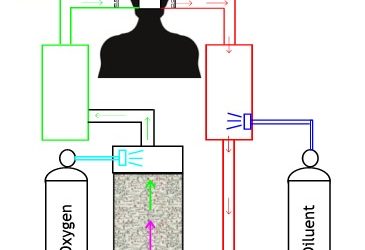Vademecum
MCCR in Depth
Here the description of an SCR to MCCR plus a dive in the Netherlands
A learner’s guide to CCR operations
A rebreather learner’s guide, by Dr. Richard Pyle
Constant mass flow valves
The operation of a CMF valve in detail
How Dolphins work
Read here about the principles of constant mass flow, an article by Nevil Adkins
Fact and Fiction-Rebreathers and CO2
Expert diver and rebreather builder Kevin Gurr explains the facts and fiction about rebreathers and Co2
Semi Closed Rebreathers
How do semi-closed rebreathers work?
ECCR explained
ECCR explained
Temperature stick
In 2002, Pete Steggle made one of the first temperature sticks for measuring at the scrubber
Stages, adding safety
Stages, your life-saver
Counterlung position
The position of the counterlung
Valves for diving cylinders
What should you pay attention to when choosing a valve for pure oxygen?
Scuba rebreather cylinders
Some interesting information on diving cylinders
Single or dual bottles
Can you tell from the cylinders which rebreather you are dealing with?
Gases and the influence of temperature
Why does an air spray can become cold when emptied and a scuba bottle become hot when filled?
Bailout valves
The BOV, a lifesaver and luxury safety device
Mouthpiece valves and gas routing
The rebreather mouthpiece plays a crucial role in the gas routing and safety of the diver.
Rebreather Full Face Masks
Information about Full Face Masks FFM for rebreather divers
Rebreather training organisations
Where can I get training to learn to dive with a rebreather?
Carbondioxide Scrubbers for Rebreathers
This article on scrubbers describes only part of the current knowledge on carbon dioxide absorbing systems. These descriptions cover scrubbers for breathing systems in mining as well as systems for underwater use.
Chemical oxygen rebreather
Oxygen rebreathers based on a chemical process are among the oldest types. The system uses chemicals that absorb CO2 and generate oxygen. As early as 1930, a whole series of devices under the name Naszogen was put on the market in Germany.
Liquid oxygen rebreather
Liquid oxygen has been used in breathing systems since the 1920s. The principle is relatively simple. Liquid oxygen has a temperature of approximately -185 degrees Celsius (-301 F) and will evaporate at room temperature.
Single bag type counterlung
Most oxygen rebreathers use a simple single counter lung. Materials used in the early days are finely-woven fabrics, impregnated with rubber or latex.
Split counterlungs
Split counterlungs are used when there are two counterlungs, one for the inhaled gas and one for the exhaled gas.
Dual hose configuration
The most characteristic external feature is that a rebreather user uses a breathing hose with an inlet and an outlet. With the exception of oxygen rebreathers, almost all modern rebreathers have separate counter lungs and separate hoses for supply of oxygen-rich gas and removal of Co2-rich gas.
Counterlung form
Counter lungs are in most cases made of flexible materials. In some special cases the designer chooses for a more rigid material.
Sidemounted hoses and rebreathers
This post is about the routing of breathing hoses. This technique has also created a special rebreather for underwater use, which is specifically used for narrow passages underwater.
Single hose breathing
Single hose systems are always pendulum systems. The original oxygen rebreather often had a single hose because this was constructively attractive.
Front or back mounted counterlungs
We distinguish different types of counterlungs used with rebreathers. On land, the choice of whether the counter-lung is worn on the chest or the back will make little difference to the breathing resistance.
On demand oxygen addition
In 1920, the first rebreather was developed that operated with a then new mechanism. Until then, the supply of oxygen to the breathing circuit had been reserved for regulators that injected gas continuously, or by manually operated valves.
Cooling system in rebreathers
For applications requiring entering a room with high temperatures or breathing for long periods from a closed system, the temperature in the breathing circuit can become higher. For this reason, since 1930 some breathing apparatus has been equipped with an integrated cooler.
Counterlung operated valve
In 1920, the first rebreather was developed that operated with a then new mechanism. Until then, the supply of oxygen to the breathing circuit had been reserved for regulators that injected gas continuously, or by manually operated valves.
Manual addition
The use of manual addition in oxygen rebreathers is the oldest form of adding oxygen to the loop.
Scrubber in counter lung
Oxygen rebreathers with build in scrubber placed in the couter lung.
Constant Mass Flow
This part with the theory of oxygen rebreathers deals with the technical principle of a constant mass valve.
Constant Mass Flow valves and Orifices
I made this page because there were many questions in newsgroups about gas flow through an orifice. Many people are now developing manually operated constant-dosis rebreathers.
Rebreathers in-depth.
This page deals with the various design aspects of oxygen rebreathers. The page is a living page and can be completed with knowledge of the readers.



































